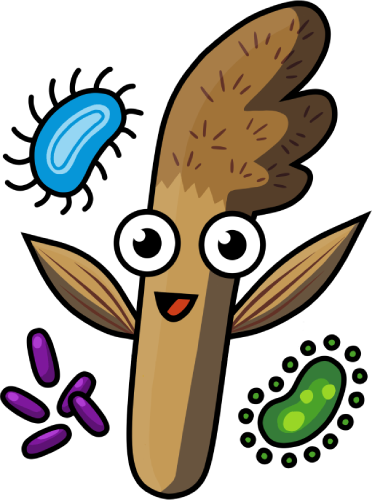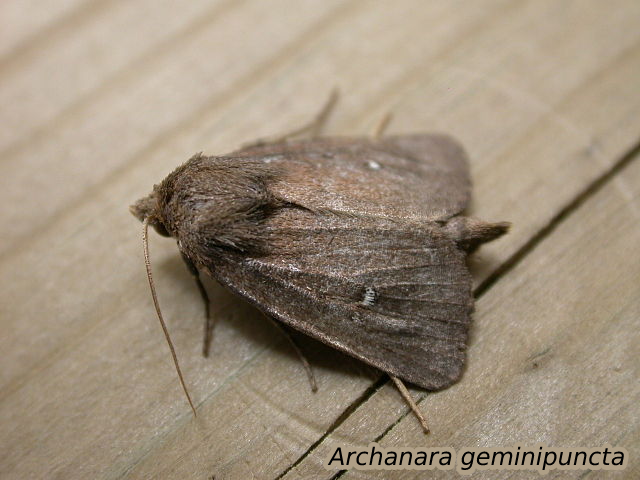
Biological Control
Could introduction of a new insect species impact non-native Phragmites?
Nonnative plant species are often successful in new environments due to reduced effect from wildlife and pathogens. In some instances, scientists are able to identify natural predators of the invasive species and intentionally release them in hopes that they will decrease the population of the invasive species. Introducing a non-native species is a complicated issue and requires rigorous testing and evaluation before such a release is approved. In terms of Phragmites, finding a biological control agent means looking for insects from Europe that would target non-native Phragmites and releasing them in North America. Other examples of biological control include the introduction of beetles to control purple loosestrife and the introduction of salmon into the Great Lakes to control alewives.
In recent years, scientists at have been studying insects that prey on Phragmites. Researchers have evaluated the host-specificity of each insect species in preparation for wide-spread releases of insects that may help control Phragmites populations. It is important to find insects that will specifically target nonnative Phragmites because introducing a new insect to North America that is not specific to Phragmites could cause even more damage to these fragile ecosystems.
From a list of over 150+ potential European insects that damage Phragmites, researchers narrowed focus to two moths in the family Noctuidae, Archanara geminipuncta and Archanara neurica, for biocontrol in North America. These moths are highly host specific to nonnative Phragmites, boring into the stem as larvae to feed and reducing over 60% of stem biomass in field tests (Häfliger et al. 2006). Release of Archanara moths in Canada for control of Phragmites was approved by the Canadian Food Inspection agency in 2019. In the United States, the Technical Advisory Group for Biological Control Agents (organized by APHIS, the Animal and Plant Health Inspection Service) approved Archanara moths for field release in April 2019, but additional approvals and permits are still pending as of December 2023. Current projects in Ontario are focused on surveying Phragmites populations for candidate biocontrol testing sites and preparation for rearing of live insects.
Photo (left): Adult Archanara geminipuncta moth (Donald Hobern, CC BY 2.0, via Wikimedia Commons)
Resources:
- Biocontrol webinar presented by Dr. Bernd Blossey, Cornell University (2013)
- Biocontrol webinar presented by Dr. Michael McTavish, University of Toronto (2022)
- Open access report: Identification, Development, and Release of Insect Biocontrol Agents for the Management of Phragmites australis
- Potential for Biological Control of Phragmites australisin North America. Paper published in Biological Invasions 23(5)
- Damage based identification key for insects feeding inside Phragmites shoots
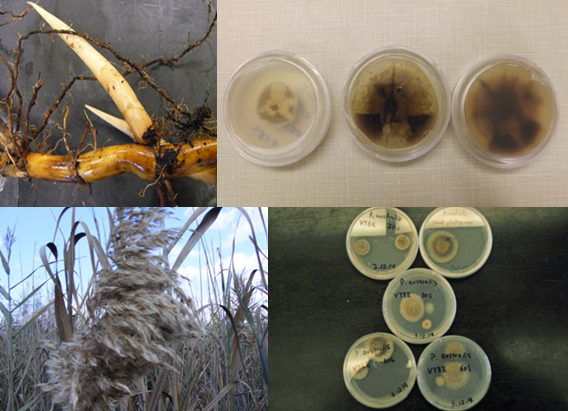
Microbial Control
Could manipulation of microbial associations reduce the competitive advantage of non-native Phragmites?
All plants host a diverse suite of microbes, such as fungi and bacteria, throughout all stages of the plant’s life cycle (Fig. 1). Much like the microbial associations humans rely on for critical functions like digestion, plants also associate with microbes that perform important roles. Some of these microbes form relationships that are mutually beneficial, or symbiotic, and are thought to confer many benefits to plants including tolerance to certain stressors, accelerated seedling development, and increased access to nutrients. As a result, symbiotic relationships with microbes can improve the performance and competitive ability of some plants.
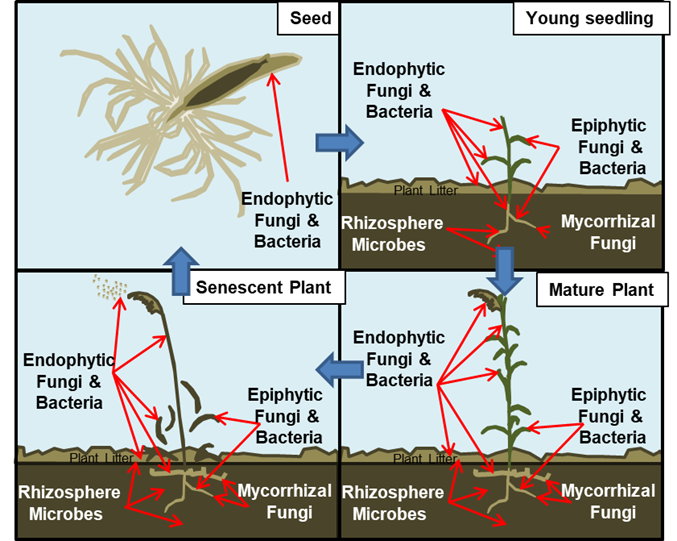
Fig. 1. Phragmites plants associate with microbes at all growth stages. Some microbes directly impact plant performance positively by increasing access to nutrients or improving defenses, or negatively through pathogenesis, Others may have indirect effects by releasing nutrients as decomposers of dead litter (Kowalski et al. 2015).
Researchers at the USGS Great Lakes Science Center (GLSC) are examining the role of microbes in both the success of invasive Phragmites and as a potential mechanism for restoring native plant assemblages. Scientists believe that studying microbial symbiosis may be integral to understanding non-native plant invasions.
If invasive Phragmites strengthens its competitive advantage due in part to positive interactions with the microbial community, then control efforts focused on disrupting these interactions may decrease Phragmites’ competitiveness. Scientists are seeking to better understand the microbes associated with invasive Phragmites and the benefits they confer to their host (Fig. 2). The ultimate goal of this research is to identify new control methods based on microbial symbiosis that give land managers another tool in their toolbox for managing this invasive species. The ability to combat Phragmites from multiple fronts in an integrated manner will lead to improved success over traditional control methods.

Fig. 2: Phragmites rhizomes (top left) and seeds (bottom left) and the fungal endophytes cultured from each plant part (right). Plants were collected by researchers at the GLSC and cultures performed by Indiana University. IU researchers will later inoculate Phragmites plants with individual endophyte species to assess the roles played by each type.
To maximize the collective impact of research efforts, the GLSC is using a collaborative approach by assembling a team of scientists with expertise in microbial ecology to focus on Phragmites microbiome. This group of scientists, known as the Collaborative for Microbial Symbiosis and Phragmites Management (i.e., the Phragmites Symbiosis Collaborative), was formed to coordinate research efforts to explore mutualisms between microbes and Phragmites. The Great Lakes Commission facilitated the development of the collaborative and continues to provide critical support. The members outlined a scientific agenda (Fig. 3) to guide their research activities going forward, with each researcher bringing their own expertise to collaborative research projects that are focused on developing a comprehensive microbe-based Phragmites control approach (Kowalski et al. 2015). The group meets regularly to discuss progress towards the agenda’s goal as well as the current state of symbiosis science.

Fig. 3: Major steps of the Phragmites Symbiosis Collaborative science agenda (Kowalski et al. 2015).
The structure of the Phragmites Symbiosis Collaborative lends support for individual research projects targeting a specific component of the science and integrates these projects to foster progress towards a broader overall goal of effective and efficient Phragmites control. For example, the GLSC is currently working with researchers at Tulane University and Rutgers University to identify fungal and bacterial endophytes present in Phragmites and to identify their roles in the plant.
Past Projects
The efforts of the PSC have significantly improved the understanding of how Phragmites interacts with microbes. For instance, we know that Phragmites hosts a diverse community of fungi in its leaves, stems, and rhizomes (known as endophytes) and the composition of that community is likely site dependent (Clay et al. 2016). Although, Phragmites inoculated with common fungal endophytes does not outperform uninoculated plants (Quach et al. 2022), and the fungi hosted by Phragmites seeds may influence germination rates (Shearin et al. 2018). In saline environments, salt tolerance of Phragmites is improved when roots host particular endophytes (Soares et al. 2016).
Current projects
Armed with a strong understanding of how Phragmites interacts with microbes, USGS and other PSC partners are developing new bioherbicides to manage Phragmites. These concoctions are designed to disrupt symbioses and alter plant hormones to turn ordinary microbial hosts into pests of Phragmites. GLSC is currently testing these treatments in field applications.
Resources:
- Symbiosis webinar presented by Dr. Kurt Kowalski and Dr. Wes Bickford, USGS-Great Lakes Science Center (2014)
- Phragmites Symbiosis Collaborative website
- Management Tools for the Control of Invasive Phragmites to Foster the Restoration of the Great Lakes
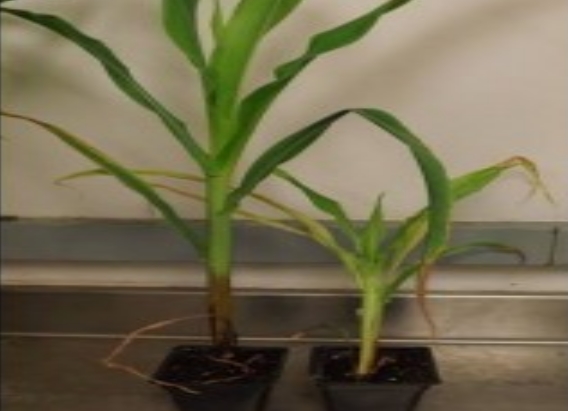
Gene Silencing
What if land managers could treat Phragmites without fear of affecting other plant species or the environment? What if this treatment specifically targeted the traits that make Phragmites most problematic?
That’s what scientists at Wayne State University and the U.S. Geological Survey are working towards, and their approach starts with a basic understanding of where these traits originate: within a plant’s genes.
Genes give instructions used in plant development and function. For example, genes dictate the design, color, and emergence of flowers on a plant. Genes also regulate key plant processes like photosynthesis and seed production. Genes drive plant processes by coding for the formation of specific proteins that ultimately result in the expression of various traits. Scientists have known for some time that protein formation can be disrupted by preventing these genetic messengers from reaching their destination. If the genes cannot send their code, the proteins are not formed and the trait is not expressed. This process is known as “gene silencing.” By understanding the genetic make-up of Phragmites, scientists can target specific traits and silence the genes that code for them. Researchers at the GLSC, Wayne State University and the U.S. Army Corp of Engineers Engineering Research and Development laboratory (ERDC) think this technology could be used to develop new forms of Phragmites control. Phragmites gains a competitive advantage over other species through its ability to grow rapidly and shade out other species, produce many seeds, and expand its underground root network over a large area. GLSC and ERDC scientists are working on ways to silence important genes in Phragmites (e.g., those for flowering, seed set, and photosynthesis) to reduce its competitive advantage.
GLSC has also partnered with researchers at Tulane University and Louisiana State University to sequence, describe, and publish the complete genome of Phragmites australis (Oh et al 2022). The team is now working on describing the genome of the North American native Phragmites in hopes that comparisons point to the genetic underpinnings of invasiveness in Phragmites. Analysis of the genetic make-up of Phragmites will increase the effectiveness of gene silencing by targeting the genes most influential to the success of invasive Phragmites. Informed by the ongoing genetic discoveries, scientists at ERDC are developing delivery mechanisms to get gene silencing vectors into plant cells effectively. The next step will be to test the technology in the field and develop an application method that will be feasible over a large scale.
Gene silencing in Phragmites is a promising strategy because it has the potential to be superior to existing control methods. For instance, because this technology targets a specific genetic message, it is thought to be entirely species specific. Additionally, the silencing effects are transient in that they cannot spread within the plant or be transferred to offspring. Unlike the process to genetically modify crops, this process does not alter the genome (i.e., ‘hard-wired’ genetic material). That means that land managers may be able to treat rapidly expanding or well-established stands of Phragmites without having detrimental effects on other plant or animal species. Gene silencing may offer land managers an additional tool to add to their arsenal against this aggressive invader, and one that may even prove more effective over the long term.
Image (left): Maize plant with silenced genes coding for photosynthesis (right) compared to a plant of the same age without gene silencing. (Credit: Kurt Kowalski)
Resources
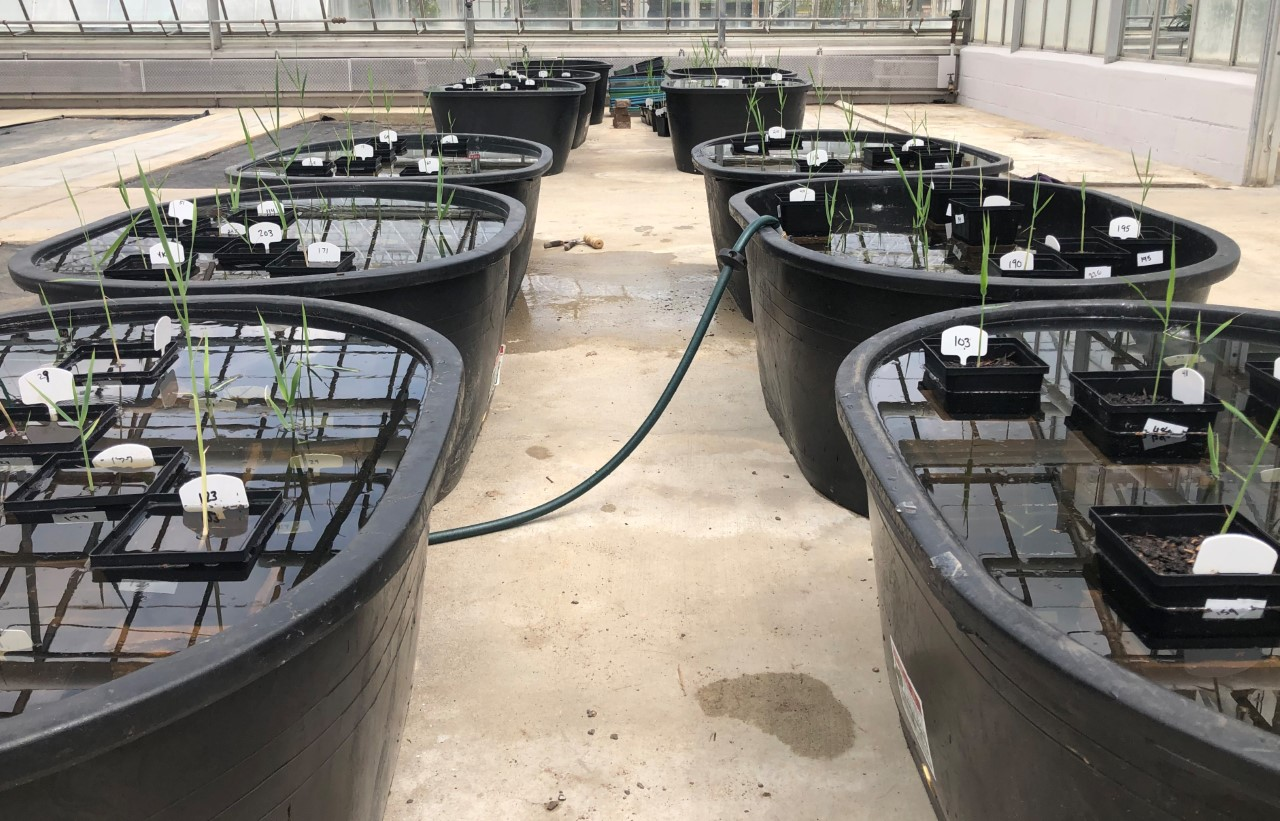
Cut-to-Drown Management
Is cutting Phragmites underwater an effective treatment option?
The GLSC was awarded a Science Support Partnership grant to work with the U.S. Fish and Wildlife Service to examine how fluctuating Great lakes water levels are impacting Phragmites management. Historic Phragmites expansion in the Great Lakes region has been tied to lake levels in that invasion zones have generally increased during prolonged low water and decreased slightly in prolonged high water. This study aims to help managers take advantage of high water periods to control large zones of Phragmites growing in high water.
In particular, the GLSC is studying the effectiveness of cut-to-drown Phragmites management strategies, whereby Phragmites plants that are growing in water at least 18 inches deep are cut below the water line, cutting off the flow of oxygen below the surface and drowning plants. In summer 2021, GLSC set up a controlled experiment that subjected potted invasive Phragmites australis plants to various combinations of water submergence levels and stem cutting treatments. The cut-to-drown treatments were extremely effective at killing Phragmites plants in controlled conditions. This study will continue in larger, established, natural populations across the Great Lakes basin. The aim is to fill critical gaps in understanding the consequences of high lake levels on Phragmites spread and the long-term success of cut-to-drown Phragmites management strategies.
Image (left): A view of the experimental set-up located at the University of Michigan’s Matthaei Botanical Gardens (Ann Arbor, Michigan) in June 2021. Within each tank a random subset of plants was elevated to different heights to apply various water depth treatments. (Credit: Spenser Widin, USGS)
Resources
- StoryMap: Phragmites Management and Variable Great Lakes Water Levels
- Cut-to-drown webinar by Dr. Wes Bickford, Spenser Widin, and Kaira Liggett, US Geological Survey Great Lakes Science Center (2023)

